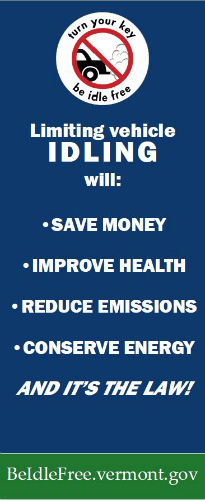Mobile Sources
Reducing Diesel Emissions: What Vermont is Doing
 ';
}
else {
ele.style.display = "block";
imageEle.innerHTML = '
';
}
else {
ele.style.display = "block";
imageEle.innerHTML = ' ';
}
}
';
}
}Be Idle Free
 In Vermont, motor vehicles are the largest source of greenhouse gases and a number of other air pollutants that threaten human health and our environment. Unnecessary idling harms human health, pollutes the air, wastes fuel and money, and causes excess engine wear. And it’s against the law.
In Vermont, motor vehicles are the largest source of greenhouse gases and a number of other air pollutants that threaten human health and our environment. Unnecessary idling harms human health, pollutes the air, wastes fuel and money, and causes excess engine wear. And it’s against the law.
Diesel Emissions Reduction Projects
 ';
}
else {
ele.style.display = "block";
imageEle.innerHTML = '
';
}
else {
ele.style.display = "block";
imageEle.innerHTML = ' ';
}
}
';
}
}Diesel Emissions Reduction Assistance
The U.S. Environmental Protection Agency awards grants under the Diesel Emissions Reduction Act (DERA) to assist States in their efforts to develop diesel emissions reduction programs. The Vermont Diesel Emissions Reduction Financial Assistance Awards were developed to provide technical assistance and incentive funding for projects that reduce diesel emissions from engines, vehicles, and equipment in Vermont with the goals of reducing public exposure to emissions from diesel-powered engines and the associated risks to public health and the environment.
Vehicle Emissions Inspections and Maintenance
Vermont’s Vehicle Emissions Inspection and Maintenance Program helps to ensure that Vermont vehicles remain clean throughout their useful lives by requiring annual testing of vehicle emissions control systems and repairs if needed. The program is managed jointly by the Department of Motor Vehicles and the Air Quality and Climate Division.
Low Emission Vehicles
Motor vehicles, while an essential mode of transportation in a rural state like Vermont, are a major source of air pollutants that are associated with a variety of environmental and human health threats, including, but not limited to climate change, ground level ozone, air toxics, acid precipitation, and regional haze.
Mobile Sources
Mobile sources, primarily motor vehicles, are a significant source of air pollutants in Vermont including air toxics, the ozone precursors (volatile organic compounds and nitrogen oxides), and carbon monoxide. Motor vehicles also represent the largest source of greenhouse gas emissions in Vermont. In order to reduce the impact of mobile source emissions on air quality and human health, the Mobile Sources Section implements and manages a number of programs and strategies for controlling on-road and non-road mobile sources of air pollution.

